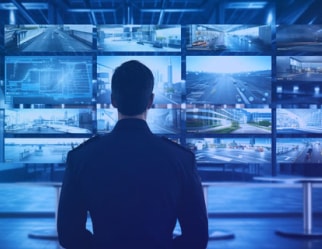Video Wall Design and Installation Considerations
Video walls have become a prominent feature in various professional audiovisual (Pro-AV) applications, transforming how information is presented and enhancing visual experiences. These large commercial digital displays consist of multiple screens seamlessly arranged to create a single, cohesive canvas for showcasing dynamic content. From corporate boardrooms and control centres to retail environments and event venues, video walls are employed to captivate audiences, deliver immersive experiences, and convey information effectively. This article will explore the key considerations and steps involved in designing, installing, and applying video walls in various Pro-AV settings.
Applications of Video Walls in Pro-AV
Video walls find versatile applications in a wide range of Pro-AV settings. Let's explore some of the prominent applications:
- Control Rooms and Command Centers: Video walls are used extensively in control rooms and command centres to monitor critical operations, security surveillance, and real-time data visualisation. The large canvas provided by video walls allows operators to have a comprehensive view of multiple information sources simultaneously.
- Digital Signage and Advertising: In retail environments, airports, malls, and public spaces, video walls serve as captivating digital signage and advertising platforms. Engaging and dynamic content attracts attention and enhances brand awareness.
- Corporate Boardrooms: Video walls are employed in corporate boardrooms for presentations, video conferencing, and collaborative discussions. High- resolution displays ensure clear visuals and effective communication during meetings.
- Entertainment and Events: In event venues, concerts, and entertainment spaces, video walls create immersive experiences for audiences, complementing live performances or broadcasting live feeds.
- Education and Training: In educational institutions and training facilities, video walls aid in interactive learning, displaying multimedia content, and facilitating engaging discussions.
- Retail Analytics: In retail stores, video walls integrated with analytics software can track customer behaviour and demographics, providing valuable insights for marketing and store layout optimisation.
Design Considerations for Video Walls
Before delving into the installation process, careful planning and consideration of several factors are essential to ensure a successful video wall implementation. Here are some key design considerations:
- Purpose and Content: Determine the primary purpose of the video wall – whether it's for advertising, branding, informational display, or monitoring. Understanding the type of content to be displayed will influence the screen arrangement, resolution, and display technology.
- Viewing Distance and Angle: Analyse the viewing distance and angles to determine the appropriate screen size and the gap between individual display screens. For optimal viewing, consider the audience's position and the distance from the video wall.
- Location and Environment: Assess the physical space where the video wall will be installed. Consider factors such as ambient lighting, room dimensions, and potential obstructions that may impact display visibility.
- Screen Resolution and Aspect Ratio: Decide on the screen resolution and aspect ratio based on the content requirements and available display technologies. Higher resolutions and wider aspect ratios result in sharper and more visually engaging displays.
- Bezel Width: Bezel width refers to the gap between adjacent screens in a video wall. Minimising bezel width helps create a seamless and uninterrupted visual experience.
- Mounting and Support: Determine the mounting method for the screens – whether wall-mounted, floor-mounted, or suspended. Ensure that the structure can adequately support the weight of the video wall.
Installation Process for Video Walls
Once the design considerations are finalised, the installation process begins. This stage involves careful execution and attention to detail to create a visually stunning and functional video wall. Here are the key steps in the installation process:
- Preparing the Space: Clear the installation area of any obstructions and ensure the walls are structurally sound and suitable for mounting the video wall.
- Mounting the Screens: Install the brackets or mounts on the wall or structure according to the design plan. Ensure precise alignment and levelling to achieve a seamless appearance.
- Cable Management: Organise and conceal the power adapters, power supplies and connector cables to maintain a clean and professional look. Proper cable management, using various cable positioning tools, is crucial to prevent tangling and interference. Also, ensure that any cables placed inside walls, ceilings or other hard-to-reach spaces comply with CPR regulations.
- Aligning the Screens: Align the screens accurately to minimise bezel gaps and achieve a uniform display surface. Using alignment tools and calibration software can aid in attaining pixel-perfect alignment.
- Video Processing and Signal Distribution: Connect the video wall screens to a video processor or controller that manages the content distribution across the screens. Video processors and specialised software allow content to be displayed in various configurations, such as picture-in-picture or full-screen modes.
- Content Calibration: Calibrate each screen's colour, brightness, and contrast settings to ensure uniformity and consistency in display quality across the video wall.
- Testing and Troubleshooting: Conduct extensive testing to identify any technical issues, such as dead pixels or signal disruptions. Address and resolve any problems promptly to ensure optimal performance.
Video walls have revolutionised the Pro-AV industry, providing a powerful tool for delivering engaging and impactful visual experiences. The design and installation process of video walls requires careful planning and attention to detail, ensuring a seamless and captivating display. From control rooms to retail environments, the applications of video walls are diverse and continue to expand as technology advances. By understanding the design considerations, following a systematic installation process, and harnessing the creative potential of video walls, businesses and organisations can harness the power of visual communication to leave a lasting impression on their audiences.
For any project support, reach out to our Support Services Team








